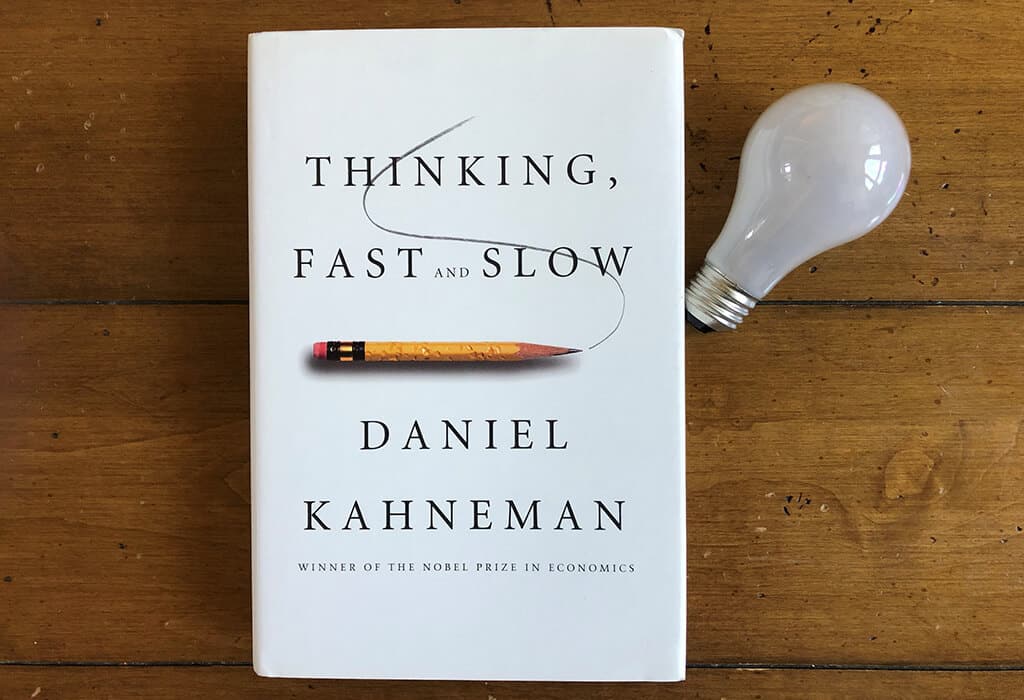Thinking, Fast and Slow by Nobel laureate Daniel Kahneman explores how our brains make decisions through two distinct systems:
- System 1: This is the fast, automatic, and intuitive system. It operates on emotions, past experiences, and mental shortcuts (heuristics) to make quick judgments without much effort. Think of it as your gut feeling.
- System 2: This is the slower, deliberative, and logical system. It’s responsible for complex calculations, reasoning, and conscious control. However, System 2 is lazier and often defers to System 1 unless a situation demands its attention.
The book delves into the strengths and weaknesses of each system. While System 1’s quick thinking is essential for daily life, it can lead to biases and errors in judgment. System 2, while more reliable, is prone to laziness and can be easily influenced by System 1’s initial impressions.
Kahneman explains various cognitive biases that stem from System 1’s dominance, such as overconfidence, anchoring (focusing too much on initial information), and loss aversion (disliking losses more than enjoying gains).
By understanding how these systems work, the book offers strategies to improve our decision-making. This includes recognizing situations where System 1 might lead us astray and employing System 2 for more critical thinking.
Overall, Thinking, Fast and Slow sheds light on the fascinating workings of our minds and provides valuable insights for making better judgments and avoiding common thinking traps.
Ball and Bat Problem
The bat and ball problem is a classic example used in Kahneman’s book “Thinking, Fast and Slow” to illustrate the different ways our brains process information (System 1 vs. System 2). Here’s the breakdown:
The Problem
A bat and a ball cost $1.10 in total. The bat costs $1.00 more than the ball. How much does the ball cost?
The Trap
Many people intuitively answer 10 cents. This answer comes from System 1, the fast and automatic thinking system. It takes the information about the price difference and applies a simple rule (“$1 more”) without fully analyzing the situation.
The Solution
System 2, the slower and more deliberative system, can solve this problem accurately. Let’s represent the ball’s price with “b.” We can then set up an equation based on the given information:
• b (ball price) + (b + 1) (bat price) = $1.10
Combining like terms:
• 2b + 1 = $1.10
Subtracting 1 from both sides:
• 2b = $1.00
Dividing both sides by 2:
• b = $0.50 (or 5 cents)
Therefore, the ball costs 5 cents and the bat costs $1.05 (5 cents + $1).
The Key Takeaway
The bat and ball problem highlights how System 1 can lead us to quick but incorrect answers if we don’t engage System 2 for critical thinking. It demonstrates the importance of slowing down and carefully considering all the information before jumping to conclusions.
The Lion and Child Example from “Thinking, Fast and Slow”
The lion and Child example from “Thinking, Fast and Slow” isn’t about a literal encounter with a lion and a child. It’s a hypothetical scenario used to illustrate how System 1, our fast and intuitive thinking, can lead to biased judgments.
Here’s the gist:
Imagine a primitive human living in a dangerous environment. One day, while venturing out with his child, they encounter a lion. Tragically, the lion attacks and kills the child. Understandably, the father develops a strong fear of lions.
Later, on another outing with another child, a large bird suddenly flies overhead. Startled by the unexpected event, the second child also drops dead.
The Flawed Reasoning:
System 1, wired for survival and pattern recognition, might jump to the conclusion that birds are just as dangerous as lions. It creates a mental shortcut: “Seeing a large animal overhead leads to child’s death.” This is a classic example of mistaking correlation for causation.
The Point:
This scenario highlights how System 1 can lead us to form quick associations based on limited information. While the fear of lions might be justified, fearing all large flying creatures due to a single isolated incident is an irrational response.
Kahneman uses this example to emphasize the importance of System 2, the slower and more deliberative thinking system. In real-life situations, we need to engage System 2 to analyze the situation critically and avoid falling prey to such biases. We should consider all the relevant information before making judgments or generalizing from a single event.
Key Learnings
Cognitive Biases
We all have mental shortcuts that can lead to predictable errors in thinking. The book identifies common biases like anchoring (focusing too much on initial information) and loss aversion (disliking losses more than enjoying gains). By understanding these biases, we can be more mindful of their influence and make better decisions.
System 1 vs System 2:
Recognizing when each system is in control can be helpful. When facing complex choices, we can consciously engage System 2 for more deliberative thinking.
Thinking Traps
The book highlights common pitfalls like the planning fallacy (underestimating the time and effort required for tasks) and the framing effect (how the presentation of information influences our choices). Being aware of these traps helps us avoid them.
Overall, Thinking, Fast and Slow offers valuable insights into how our minds work and how we can improve our decision-making. By understanding the interplay between System 1 and System 2, and the biases that can cloud our judgment, we can become more rational and effective thinkers.
